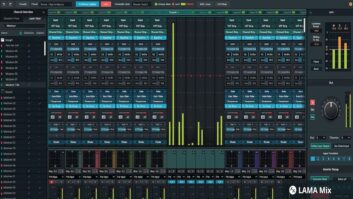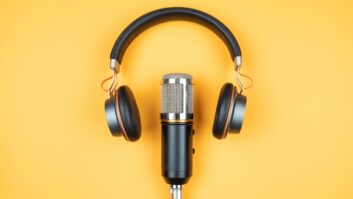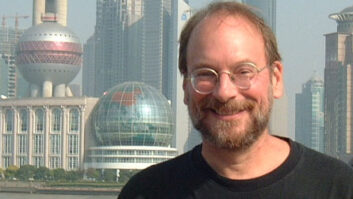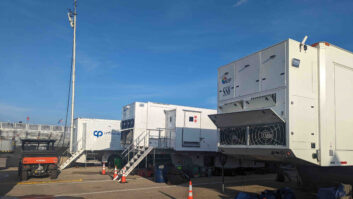ELECTRONIC ARTS, VANCOUVERWalking into the Electronic Arts Canada facility in Burnaby, B.C., near Vancouver, is a bit like entering a NASA research complex. But after you pass through the security gates and walk into the open, modern foyer, it quickly becomes obvious that the work being done here, while not exactly rocket science, is an awful lot of fun. A huge backdrop of TV screens behind the reception desk plays video intros from various games, while people meet for a workout in the gym or on the private soccer field, watch a movie in the surround sound movie theater or play the newest video games in the amusement area. There’s even a cappuccino bar on every floor.
With sales from games developed here reaching half a billion dollars, EAC set out to build the ultimate workplace for its more than 600 employees. Ground-up construction on the 210,000-square-foot development house began in 1997 and was completed in early 1999. Decisions were made early on to keep creative teams intact on the upper floors, in an open cubicle environment. Sound design, computer graphics and programming takes place on the desktop within those creative teams, with finishing work in the basement, where 14 video edit rooms, three audio studios and two composing rooms share about 9,000 square feet.
The A/V area in the basement, if it’s fair to call a space with windows a basement, was designed by John Storyk of Walters-Storyk Design Group, with technical consulting by local studio guru John Vrtacic, supervision by Edwin Dolinski, audio operations director at EA Canada, and construction by Kodama Woodworking Inc. Studio A, the main mixing room, features a Euphonix CS2000M console with a 48×12 Cube, configured for mono, stereo and 5.1 mixing.
Dolinski says, “In addition to the sound designer offices upstairs, we needed some isolated studios to handle music recording and mixing, audio post and dedicated speech recording. When we contacted John Storyk, we were looking for something that not only provided the functionality that we needed but also looked as good as the rest of our stunning new building.”
The initial challenge for Studio A, Dolinski says, was to somehow increase the height to gain cubic volume. “We already had the studios located on grade,” he says, “and we had the best chance of keeping things quiet in the basement. But Studio A, our showpiece, was planned for just 900 square feet, with a 600-square-foot control room, so we needed the extra height. When John Storyk came onboard, he was able to talk the planners into digging down an extra four feet to solve the problem.”
“It had to be a tracking room, it had to work as an overdub, Foley and ADR-type of room, and it had to be a post-production room with a screen that comes down, a projector and 5.1 monitoring,” Storyk explains. “Once I knew I could get my volume, I made the room sort of down the middle. It’s a middle-of-the-road reverb time, so it can work when you need it dead, with rugs and goboes, but it’s also bright when you want to bring in five or 10 strings.”
The Studio A control room houses a 5.1 Westlake monitoring system (BBSM12s all around, powered by passively bi-amped Bryston 4Bs; two Bag End subs), and a producer’s desk can be used to lay out drum machines and keyboards, both of which regularly make their way into sessions. To counteract the problems of front-facing glass, the team went with a motorized screen and projection system.
“The rest of the plan for the basement is pretty straightforward,” Storyk says. “There are three audio rooms that are detached acoustical environments, but they are all on one side of the universe, all talking to a central audio machine room. Then on the other side of the facility, the video editing suites have their own machine room. And the two machine rooms talk to each other through a wire raceway system. If you look through the geometry, which has some interesting angles, then you’ll see that it’s a simple circumnavigational corridor scheme. On top of the corridor scheme is a circumnavigational conduit raceway scheme. Very simple. Very elegant. No room is more than one wall penetration from a wire highway. It’s not earth-shattering, but it was there from the beginning.”
NEW TECHNOLOGIESThe key to the success of the EA Canada sound team was fostering an environment of cooperation and collaboration among employees. “We all learn from each other all the time,” Dolinski says. “Each sound designer, speech specialist or composer was hired for their ears and digital audio skills – not their ability to write computer code.
“Then again, the thing that makes this approach work is the fact that we’ve got four full-time, top-notch programmers that are writing the audio libraries and the audio tools that enable us to put the sound into the games,” he adds. “It’s only a function of scale that we can afford to do that. The game programmer can then put the control in the hands of the sound designer, who says, `This is how I want my sounds to work.’
“For example, we have a program that deals with the randomization and building of sentences for speech,” he continues. “It’s called SED, or Speech Event Designer, which handles seeking out the individual samples and streaming them off the CD and loading them into RAM so that they’re ready for the code to control. Sentences are then automatically built on the fly following certain randomization criteria to help keep the variety up. We also have an orchestration program so that you can build the banks of the sound effects that are going to go into RAM and be fired off by the game. Each sound effect comes with a number of parameters to it so you can place it in 3-D space, set its volume and then randomize, within certain limits, its pitch, volume and pan on sample playback.”
Currently in the works is a prototype called the Audio Event Management System, which provides even more control based on game events. If the AI passes an event that says a goal is scored, for instance, it kicks off a new stream for the crowd reaction, music over the P.A., and so on. A whole cascade of sonic events can come from one game event.
The sound department at EA Canada will go to great lengths to re-create an audio experience for a game, in many ways similar to the way a big-budget feature film would. Sounds recorded in different environments at different times are layered together seamlessly to provide a realistic, believable world within the games. If you’re not watching while someone is playing a basketball or hockey game, it’s easy to be fooled into thinking you’re hearing an actual broadcast.
NBA 2000For a title like NBA 2000, the sound team might start by renting a gymnasium or arena and recording isolated sounds, such as shoe squeaks, balls dribbling and shooting, hoop swooshes, backboard hits, and so forth. Once they are happy with those, they will arrange to go to Vancouver Grizzlies or Canucks games for more recordings. Because EA Canada has a relationship with the major sports leagues, the broadcasters that work the games allow access to the mic feeds already in place. In addition, they have people roaming the crowd with mics and DAT machines, recording everything from hecklers to vendors to crowd cheers. The sound team assigned to each game may also go through tapes of games and grab isolated sound bites.
“We put huge efforts into the crowd sounds in the sports games,” says Dolinski. “There’s layers of `crowd’ streams dovetailing on top of each other with real-time filters and crossfading so that it responds organically like an actual crowd. It’s pretty easy to spot weak sound design, where you hear a basic white noise crowd looping the entire game.” The next step is to have the real play-by-play announcers and color commentators come into the studio to do scripted lines, as well as on-the-spot improv banter.
“The planning that’s up front is huge,” says Dolinski. “Not only do you have to assemble all the different bits of source and put them into a coherent whole, you’ve got to work with the rest of the team to make sure you’ve got the resources, the RAM, the access to the CD, and so on. And even that gets changed as the game evolves, and you have to respond to that.”
At some point, the main studio will record music for the game intros, transitions and menus. Although most music is composed and created in-house, in the case of NBA 2000, a group dubbed the “NBA Orchestra” was brought in one by one to do their drum, bass, guitar and horn parts in Studio A. The segments were then mixed and chopped up in Digital Performer by composer Traz Damji to create seamless music sequences. In other instances, EAC will take tracks from local bands like Facepuller, Templar and Econoline Crush and remix them for game intros; in other cases they’ve collaborated on new material with Mixmaster Mike and Montel Jordan. Typically, guitar tracks are re-recorded by in-house guitar whiz Saki Kaskas, while mix engineers Ken “Hi Watt” Marshall and Francois Lafleur apply processing and remixing techniques to fit in with EAC’s “signature” sound.
One of the more interesting aspects of game design is that there never really is a “final mix,” because the mix is created as the game is played. Although there are similarities between film sound and game sound design and mixing, Dolinski maintains that there are also some significant differences. “In some ways film sound is a lot easier than this, because you know exactly what’s going to happen, you know what action is coming up,” he says. “You can foreshadow, you can do sounds in response to things, and you have unlimited resources in terms of how many sounds you can layer, how you mix them, how you pre-process them, because you’ve got a very set sequence of linear events that is going to happen. With games, you’ve got hardware restrictions on the number of voices that a game will play, and then how do you prioritize that? When you run out of voices, do you steal them from the P.A. announcer or let the crowd go?”
The future of games is in some small way tied to the shift to DVD, which will allow the sound designers and programmers to expand the capabilities of the games. One of the most enjoyable aspects of playing an EA game, like NHL 2000 or Need For Speed, is the realism that is achieved both in the graphics and accompanying soundtracks. With the coming generation of DVD-based game platforms, including the new Sony Playstation 2, there will be a giant leap to push the reality aspect of games further.
“We’re certainly developing more elaborate tools to put more power into the hands of the sound designers,” concludes Dolinski. “In terms of DVD, we’re hopeful that we can start squeezing in some of the 5.1 surround encoding. It gets that much more immersive, the whole game experience, if you can specifically tailor the entire aural environment. There’s nothing more powerful than hearing a sound coming at you from somewhere, like a car passing, before you see the visual. It’s pretty amazing.”







